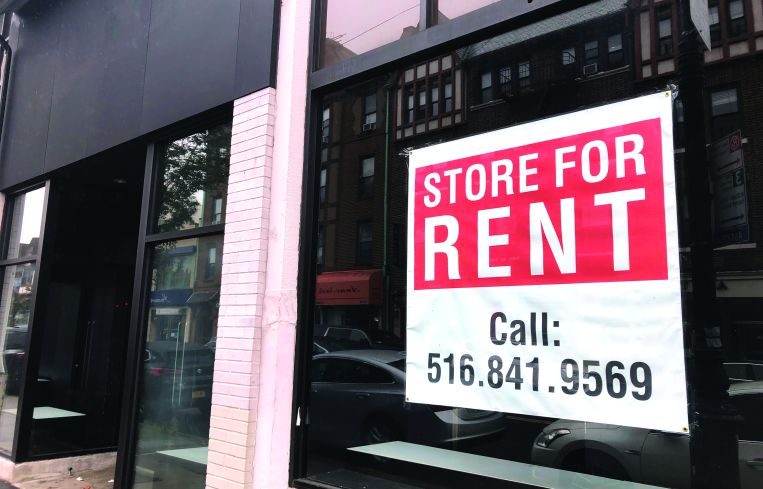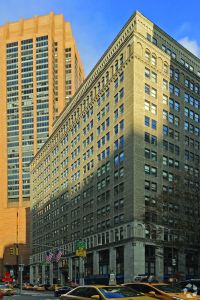Post Mortem: How New York Brokers Hustled Their Way Through 2020
By Nicholas Rizzi December 14, 2020 4:00 pm
reprints
It’s finally almost over.
After a 2020 filled with thousands of people sick and dying, job losses, beloved businesses closing, holidays spent alone, inability to see friends outside of a screen, and feeling like you’re reenacting the movie “Groundhog Day” in your home every day, 2021 is on the horizon with the hope of a vaccine.
The real estate market has faced a brutal 2020, with leasing and investment activity plummeting in New York, while retailers filed for bankruptcy and closed up shop by the dozens.
From January to November, Manhattan saw only 11.87 million square feet of office leasing activity, a 58 percent decrease from the 28.53 million square feet signed during the same time last year, according to CBRE. November’s 480,000 square feet, in fact, was a record monthly low for Manhattan and the third time the record was broken this year.

Many of the deals this year have been renewals — including the second largest of the year, NYU Langone Medical Center’s 633,000-square-foot renewal at One Park Avenue — as most companies took a wait-and-see approach in 2020.
“Unless you have to do something, why do something today?” said Michael Mathias, an executive managing director at Savills. “A lot of people are making the best use of their space and are going on with their lives.”
But, even with the bleak office leasing numbers, there have been some bright spots in the market. Facebook’s long-rumored, 730,000-square-foot deal finally closed in the middle of the pandemic in August, clinching the title of the largest office deal of the year.
It wasn’t just Facebook offering hope to Manhattan. TikTok provided some much needed good news at the height of the pandemic when it took 232,000 square feet at the Durst Organization’s One Five One in June; and Apple took another 116,000 square feet at 11 Penn Plaza in November, after the tech giant had already signed a lease for 220,000 square feet in February.
“The tech sector continues to grow during the pandemic and commit to space,” said Bruce Mosler, chairman of global brokerage for Cushman & Wakefield. “While office occupancy is low, they’re clearly making a statement about where they think people will want to be.”
And tech is one of the major reasons brokers were able to get any deals signed this year at all.
After about a month of trying to figure out how to best market buildings to prospective tenants during the pandemic, when in-person tours were all but impossible, CBRE’s Paul Amrich visited the properties himself.
“I woke up one morning and said, ‘Why don’t I just go through and walk all our buildings?’” Amrich said. “To relook at how vacancies feel and how we’re dealing with COVID.”
That’s when Amrich got an idea: Why not invite other brokers to join him virtually? So, Amrich set up a live Zoom tour of 1245 Broadway in July, where he spent 30 minutes showcasing the building and showing renderings of parts under construction. Nearly 200 people tuned in.
“Our phone blew up afterward,” Amrich said. “It almost created this connectivity to the brokerage community that everybody very much missed.”
Brokers have also relied on Zoom calls to hammer out leases. Most agreed that the pace of the video calls, along with not having enough time to switch gears between them, were draining. Though JLL’s Peter Riguardi did find some pluses to only being visible on a webcam.
“You’re able to be on a video call with the other side of the deal, and at the same time, you can be texting your colleagues ‘don’t say this, don’t say that,’” said Riguardi, whose deals this year include BNP Paribas’ 323,000-square-foot lease at 787 Seventh Avenue and Apple’s deals at 11 Penn Plaza. “We had a lot of success and it worked, but it does in no way substitute for face-to-face.”
Brokerages rapidly expanded their tech tools in general, as well as the data they provide to clients during the pandemic. This quick evolution turned out to be a silver line, executives say.
“The communication and technology level that we have with our clients today is tenfold to what it was,” Mosler said. “It caused us to up our game in terms of what our best practices are.”
Mosler said one of the things Cushman & Wakefield has focused on during the pandemic is developing plans for their clients’ workspace post-COVID-19 and giving them plenty of data on trends. That included a study that found that most millennial and Gen-Z workers crave going back to the office. It also famously included a May analysis for the so-called “6-foot office,” designed to keep workers safely socially distanced.
“This has been a moment to show your clients that you’re there for them and that you’re present,” Mosler said. “You must provide them with information on every level. It’s also an opportunity to be a leader and help them understand what the workplace of the future can look like.”
Most brokers expect office workers to flock back next year, especially once a vaccine is rolled out. Still, they say there’s plenty of ground to make up for after 2020.
Aside from decreases in leasing activity and the number of new deals, Manhattan has started to see a dramatic increase in sublease space. It stood at more than 16 million square feet in November, and Mosler expects the number to hit 18 million square feet by year-end. This spike in available sublease space has driven down rents, even in prime addresses.
“I anticipate that, the first half of next year, the people will reenter the market,” Mosler said. “And the first people in the market will look to take advantage of some of those economically beneficial leases.”
Along with the increase in sublease space, Manhattan’s availability rate hit a 16-year high in October and was 13.5 percent by early December, according to Colliers International.
“Just because we’re going to have a vaccine and just because people are going to come back to work, it’s not going to mean that the economy in the real estate business is going to turn around at the same pace,” Riguardi said. “We have a few years of inventory that we’re going to have to burn through.”
The retail side hasn’t looked much better this year and already has been working through a punishing few years dubbed a “retail apocalypse.” Leasing velocity decreased in Manhattan for the fifth quarter in a row in the third quarter of this year and dropped below 3 million square feet for the first time since 2017, according to CBRE.
Dozens of iconic brands have closed or filed for bankruptcy — including JCPenney, Brooks Brothers and J.Crew — while others didn’t come out of 2020 alive.
Department store chain Century 21, which was founded in Bay Ridge, Brooklyn, in the 1960s, announced in September that it would permanently shutter its 13 locations, while Pier 1 Imports and Lord & Taylor also went out of business in May and August, respectively.
Neiman Marcus’ 188,000-square-foot Hudson Yards outpost closed in July, a little more than a year after it opened, with developer Related Companies now marketing the space to office tenants instead.
The wave of closures and bankruptcies could worsen if a second set of lockdowns hit the city because of the rising number of COVID-19 cases.
“Most of them are just hanging on for dear life,” said Peter Braus, managing principal of Lee & Associates NYC. “If there’s another shutdown and there’s no aid package for small retailers, then that will be the last straw for a lot of people.”
However, the few retailers signing deals during this time have been greeted with some significant deals.
“If you’re smart, and you have the resources to do so, you’re going to go out and try to snap up spaces that, otherwise, you wouldn’t be able to get for these types of deals,” Braus said. “Some of these deals are not anything they’re going to see again in their lifetime.”
Braus said he has seen spaces offer rents at half of what they were pre-COVID, as well as retail tenants moving a few blocks away in search of more favorable terms, significant tenant improvement packages, and the addition of a clause in leases helping tenants in case of another pandemic.
And, unlike office tenants who have been committing to shorter-term leases in order to buy time to figure out the pandemic’s impact on their business, retailers have tended to take longer leases than before to lock in deals. Braus, for instance, said he recently signed a 20-year lease and a 22-year lease.
“If they’re going to take space, they want to lock in a great lease for a long period of time and not have to worry about what happens in five years,” Braus said. “Of course, that’s not what the owners want, but they’re not really driving the bus right now.”
As grim as 2020 looked, brokers are hopeful next year will be better, especially with a COVID-19 vaccine already being administered.
“A lot of people are gearing up for 2021,” Savills’ Mathias said. “There are a fair number of companies that have just been sitting on the sidelines.”
Cushman & Wakefield’s Mosler said that he expects there to be “pent-up demand” next year, as companies played a waiting game in 2020.
There will also be a more noticeable “flight to quality” in the office leasing market, since tenants will have to provide a better workspace to get workers to come back, Mathias said.
“The office is going to need to provide something additive to the at-home work experience,” he said. “There has to be some draw for people to come there. It can’t just be, ‘Hey, we have snacks.’”
CBRE’s Amrich is gearing up to have a strong first quarter and has started to see long-term lease commitments return for clients.
“The confidence level from the tenant community is back,” he said. “If someone was going to leave the city, they’ve left already.”
And the pandemic has brought some positives to the brokerage community with the wider embrace of technology. Riguardi guessed that half of his traveling for work could be replaced by a quick Zoom call in the future and virtual tours could help clients whittle down a long list of potential spaces to just a handful. However, he said there’s no replacement for an in-person walkthrough of an office.
“The video tours of the space are definitely effective, but I would never expect a client to make a decision based on that,” Riguardi said. “There are things that you don’t see on camera. The camera is only showing everything in its most positive light.”
Despite his success with virtual events, Amrich agreed and doesn’t expect to continue them in the future. But, one good thing the embrace of technology did give him was more time with his loved ones.
“This caused you to kind of get off the treadmill, and you got this silver lining of amazing time with [your] family and children,” Amrich said. “If there was a way that you could work your schedule, where you could get a little more family time through the use of technology, I think that’s a good result of this.”



